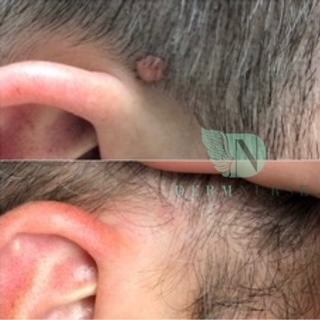SKIN MOLE REMOVAL
WHAT YOU NEED TO KNOW
ABOUT MOLE REMOVALS
ELECTROCAUTERY
Electrocauterization is a procedure that uses an electric current to remove damaged or infected tissue, or manage bleeding in tiny blood vessels.
Moles, milia, warts, skin tags, angiomas, broken blood vessels (telangiectasia), and sebaceous hyperplasia (enlarged oil glands) can detract from the skins smooth surface and clear complexion.
If there is any question as to the status of a mole, clients will be referred to their family Doctor or to their Dermatologist for assessment. Price is determined during consultation.
Popularity
Number 6 most popular treatment
Price
$99.99
Treatment Length
15-30 minutes
How Long Does It Last?
Long lasting effects
1.DISCOMFORT – Some discomfort may be experienced during treatment. A local anesthetic will be applied topically or injected to minimize pain.
2. WOUND HEALING – Treatment can result in swelling, blistering, crusting, scabbing, or flaking of the treated areas, which may require 1-3 weeks to heal. Once the surface has healed, it may be pink or sensitive to the sun for an additional 2-6 weeks, or longer
3. INFECTION -Skin infection is a possibility although rare, whenever a skin procedure is performed. Avoid picking the scab to reduce your risk of developing infection!
4. PIGMENT CHANGES (Skin Color) – During the healing process, there is a slight possibility that the treated area can become either lighter (hypopigmentation) or darker (hyperpigmentation) in color compared to the surrounding skin. This is usually temporary, but in some cases it may become permanent.
5. SCARRING – Scarring is a possibility whenever treatment involves disruption of the skin’s surface. To minimize the chances of scarring, it is IMPORTANT that you follow all post-treatment instructions carefully.
6. BLEEDING/BRUISING- Some bleeding may occur due to injection of local anesthetic and occasionally the cautery itself. Although rare, if any continuous bleeding occurs during treatment it will be addressed.
Post-treatment bleeding that won’t stop is very rare, but if it occurs, it must be reported and addressed immediately.
7. CRUSTING-There will be crusting over the treated areas. These will fall of naturally over the course of 3-7 days. Do not pick them off. This will lead to infection and scarring.
Keep scab(s) as dry as possible. To keep it clean, use gentle liquid soap (no perfume) twice a day followed by Polysporin. Do not try to remove scab. It will come off naturally.
- Do not apply heavy makeup for at least 24 hours, as it will disturb the treatment sites. This applies to treated facial areas
- No tanning one week AFTER treatment, no sauna, swimming pool or hot tub for two weeks.
- Wear sunscreen of at least SPF 30 before and after treatment to protect your skin.
- After the scab falls off, you can use ZO Revitatrol to help the skin recover faster.
- Compliance with the aftercare guidelines is crucial for healing, prevention of scarring, hyper-pigmentation, and hypo-pigmentation.
- You may need to return to the office within ten days for a follow-up.
The cost varies depending on number and size of lesions involved. A quote will be provided to you after your consultation with the Nurse Practitioner.

